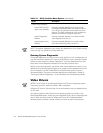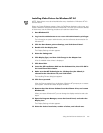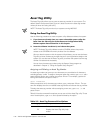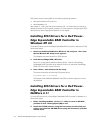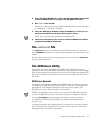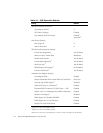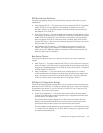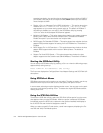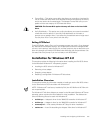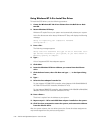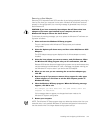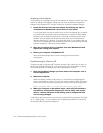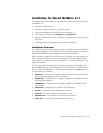
3-6 Dell PowerEdge 6300 Systems User’s Guide
Normally, you should leave the Initiate Sync Negotiation enabled, because most
SCSI devices support synchronous negotiation and because it allows for faster
data transfer.
NOTE: Some older SCSI-1 devices do not support sync negotiation. This may
cause your computer to operate erratically or hang if Initiate Sync Negotiation is
set to Yes. Set Initiate Sync Negotiation to No for these devices.
Maximum Sync Transfer Rate — This option sets the maximum synchronous
data transfer rate that the host adapter supports. The host adapter supports rates
up to 80 megabytes per second (MB/sec). The default is 80 MB/sec (the
maximum).
If the host adapter is set to not negotiate for synchronous data transfer, the
maximum synchronous transfer rate is the maximum rate that the host adapter
accepts from the device during negotiation. (This is standard SCSI protocol.)
Enable Disconnection — This option (sometimes called
disconnect/reconnect
)
determines whether the host adapter allows the SCSI device to disconnect from
the SCSI bus. Enabling disconnection allows the host adapter to perform other
operations on the SCSI bus while the SCSI device is temporarily disconnected.
The default is Yes.
Leave Enable Disconnection set to Yes if two or more SCSI devices are con-
nected to the host adapter. This optimizes SCSI bus performance. If only one
SCSI device is connected to the host adapter, set Enable Disconnection to No to
achieve slightly better performance.
Initiate Wide Negotiation — This option determines whether the host adapter
attempts 16-bit data transfer instead of 8-bit data transfer. The default is Yes.
NOTE: Some 8-bit SCSI devices may have trouble handling wide negotiation,
which may result in erratic behavior or a hang condition. For these devices, set
Initiate Wide Negotiation to No.
When this option is set to Yes, the host adapter attempts 16-bit transfer. When
this option is set to No, 8-bit data transfer is used unless the SCSI device itself
requests wide negotiation. The effective transfer rate is doubled when 16-bit data
transfer is used because the data path for wide SCSI is twice the size of normal
8-bit SCSI.
Send Start Unit — This option determines whether the send start unit com-
mand is sent to the SCSI device during the boot routine. The default is Yes.
Setting this option to Yes reduces the load on your computer’s power supply by
allowing the host adapter to start SCSI devices one at a time when you boot your
system. When this option is set to No, the devices are allowed to start at the
same time. Most devices require you to set a jumper before they can respond to
this command.
NOTE: For many devices, if Send Start Unit is set to Yes, the boot routine time
will vary depending on how long it takes each drive to start.



